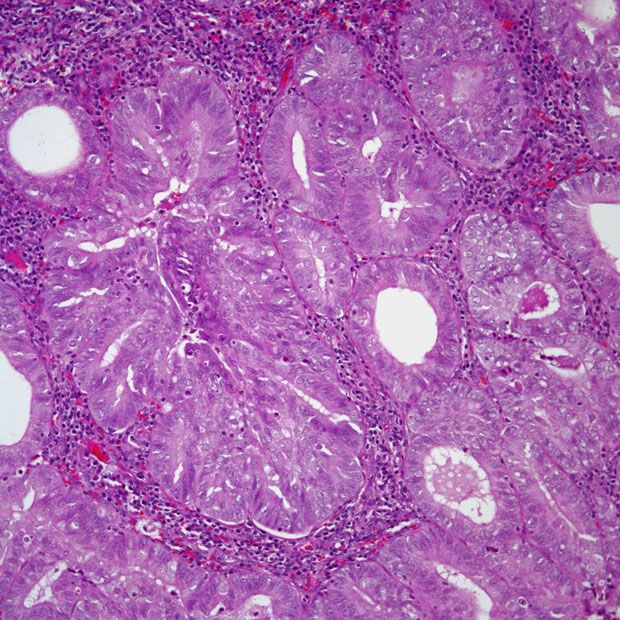Pembrolizumab Combo Yields Enduring Benefits in Advanced Endometrial Cancer
Data from the phase 3 KEYNOTE-775 trial support lenvatinib plus pembrolizumab as a standard therapy option for patients with previously treated advanced endometrial cancer.
“This exploratory analysis provides additional support for lenvatinib plus pembrolizumab as standard therapy in patients with previously treated aEC,” according to the authors of Study 309 / KEYNOTE-775 (NCT03517449).

Patients with previously treated advanced endometrial cancer (aEC) experienced durable clinical benefits when treated with lenvatinib (Lenvima) plus pembrolizumab (Keytruda) compared with chemotherapy, according to exploratory analysis findings from the phase 3 Study 309/KEYNOTE-775 trial (NCT03517449) presented at the 2023 European Society for Medical Oncology Congress (ESMO).
“This exploratory analysis provides additional support for lenvatinib plus pembrolizumab as standard therapy in patients with previously treated aEC,” the study authors wrote in their poster presentation of the multicenter, open-label, randomized phase 3 trial.
In this analysis, investigators reported the efficacy and safety results of patients who completed 35 cycles (approximately 2 years) of pembrolizumab at 200 mg intravenously every 3 weeks and continued lenvatinib alone at 20 mg orally every day after the final prespecified OS analysis. The final analysis had a data cutoff on March 1, 2022, or more than 16 months of additional follow-up after the primary analysis.
The overall survival (OS), progression-free survival (PFS), objective responses rate (ORR), and duration of response (DOR) were evaluated for this population, which were broken out into all-comer (n = 41) and mismatch repair-proficient (pMMR) (n = 30) cohorts. Safety was also evaluated in the all-comer group. The median follow-up was 34.6 months for all-comer patients and 33.9 months for patients with pMMR disease.
In both groups, the median PFS was 34.1 months, with a 95% confidence interval of 27.7 months to not estimable (NE) in all comers and 20.1 months to NE in the pMMR population. The PFS rate at 24 months was 68.3% and 66.7% for all-comer and pMMR patients, respectively, and at 36 months it was 49.3% and 46.2%.
The median OS in both groups had not been reached at the time of follow-up. The OS rate for both at 24 months was 100% and the 36-month OS rate for all comers was 89.0% and 84.3% for the pMMR population.
All-comer patients had an ORR of 63.4% (95% CI, 46.9%-77.9%) and patients with pMMR had an ORR of 63.3% (95% CI, 43.9%-80.1%). There was a complete response and partial response rate of 19.5% and 43.9% in all comers, respectively, and 23.3% and 40.0% in patients with pMMR tumors. The median DOR was not reach for either group (range, 3.5-39.5+). For the all-comer group, the probability of patients with extended DOR of 24 months or more was 83.8% and of 36 months or more was 70.9%. The extended DOR probability for the pMMR group at 24 months or more was 78.3% and at 36 months or more was 69.6%.
Additionally, the disease control rate (DCR) was 95.1% and the clinical benefit rate (CBR) was 87.8% for the all-comer population. For the pMMR population, the DCR was 93.3% and the CBR was 86.7%. In the all-comer patients, the median time to response was 3.5 months and 2.1 months for the pMMR patients.
The median duration of treatment with lenvatinib was 917.0 days (range, 735.0-1308.0) in the all-comer population. For all-comers who completed pembrolizumab and continued lenvatinib monotherapy, 95.1% had 1 or more dose reductions. There were no dose reductions in 4.9% of patients, and 1, 2, 3, or 4 dose reductionsin 14.6%, 39.0%, 19.5%, and 22.0% respectively. The median time to the first dose reduction was 2.8 months (range, 0.4-22.8).
Compared with the safety results from other solid tumors and the intention-to-treat (ITT) population in Study 309/KEYNOTE-775 who received the original pembrolizumab/lenvatinib regimen schedule, the safety results of the exploratory population were consistent.
In 33 out of 41 all-comer patients (80.5%), grade 3 or more treatment-related adverse events (TRAEs) were observed. The most common any-grade TRAEs occurring in 20% or more patients were hypothyroidism (82.9%), hypertension (70.7%), and diarrhea (68.3%). Hypertension (36.6%), diarrhea (17.1%), and weight decreased (12.2%) were the most common grade 3 or more TRAEs occurring in 10% or more of patients. However, no grade 5 TRAEs were observed.
All-comer and pMMR patients on the exploratory analysis had a median age of 59.0 years and 58.5 years, respectively (range 34.0-77.0). A majority of both groups had an ECOG performance status of 0, no history of pelvic radiation, and had a histology of endometroid carcinoma at initial diagnosis.
In the final prespecified OS analysis of the ITT population (n = 827), the all-comer group receiving pembrolizumab/lenvatinib (n = 411) had a median OS of 18.7 months vs 11.9 with either doxorubicin or paclitaxel chemotherapy (n = 416; HR, 0.65; 95% CI, 0.55-0.77). For patients with pMMR disease, the median OS was 18.0 months vs 12.2 months with pembrolizumab/lenvatinib (n = 346) and chemotherapy (n = 351), respectively (HR, 0.70; 95% CI, 0.58-0.83).
Similarly, PFS favored the pembrolizumab/lenvatinib group with a median PFS of 7.3 months compared with 3.8 months for those given chemotherapy in the all-comer cohorts (HR, 0.56; 95% CI, 0.48-0.66). There was a median of 6.7 months vs 3.8 months in the pMMR populations for pembrolizumab/lenvatinib and chemotherapy, respectively (HR, 0.60; 95% CI, 0.50-0.72). The ORR for the all-comer and pMMR populations were 33.8% and 32.4% with pembrolizumab/lenvatinib, respectively, and 14.7% and 15.1% with chemotherapy.
“The primary analysis of Study 309/KEYNOTE-775 demonstrated statistically significant and clinically meaningful improvements in PFS, OS, and ORR with lenvatinib plus pembrolizumab vs chemotherapy among patients with previously treated aEC,” the study authors stated. “These improvements in efficacy with lenvatinib plus pembrolizumab vs chemotherapy were further supported by the results of the final prespecified OS analysis.”
Reference
Colomba E, Lorusso D, McKay H, et al. Outcomes for patients (pts) with advanced endometrial cancer (aEC) who completed pembrolizumab (pembro) and continued lenvatinib (LEN) in the phase III Study 309/KEYNOTE-775. Ann Oncol. 2023;34(suppl_2):S512-S513. doi:10.1016/j.annonc.2023.09.1927